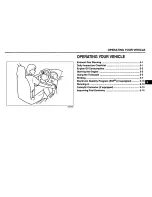
BRAKES
Service Adjustment
Brake
booster
side
Spring
Valve
Pressure
Pressure
valve
input pressure
2.
Check the operation of the check valve by using a
Vacuum pump connection Accept/reject criteria
Connection
at the brake A negative pressure (vacuum)
booster side
created and held.
Connection at the -intake
manifold side
A negative pressure (vacuum) is not
created.
Caution
If the check valve is defective, replace it as an
unit together with the vacuum hose.
PROPORTIONING VALVE FUNCTION TEST
1.
Connect two pressure gauges, one each to the input sid
and output side of the proportioning valve, as shown,
2. Air bleed the brake line and the pressure gauge.
3. While gradually depressing the brake pedal, make th
following measurements and check to be sure that th
measured values are within the allowable range.
(1) Output pressure begins to drop relative to
pressure (split point).
Standard value:
3.95-4.45
(561-633 psi
3.45-3.95
(491-561
(2) Output fluid pressure when input fluid pressure are a
follows.
Standard value:
5.15-5.65
[at 8.2
(1,163 psi))
4.65-5.15
(661-732
[at 7.7
(1,095 psi)]
(3) Output pressure difference between left and
brake lines
Limit: 0.4
(57 psi)
4. If the measured pressures are not within the permissibl
ranges, replace the proportioning valve.
BLEEDING
When the master cylinder is empty of brake fluid, bleed
from the master cylinder by proceeding with procedures
thru (6). (Because this master cylinder is not equipped with
check valve.)
When brake
remains in the master cylinder, proceed wi
step (6).
Disconnect the brake tube from the master cylinder.
(2) Two
should conduct the air bleeding, one
slowly depressing the brake pedal and holding the
depressed.
.
, .
. .
Summary of Contents for Laser 1993
Page 1: ......









































